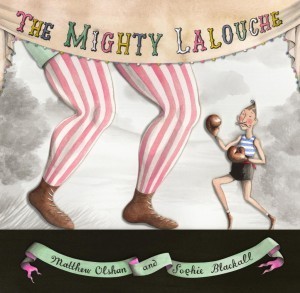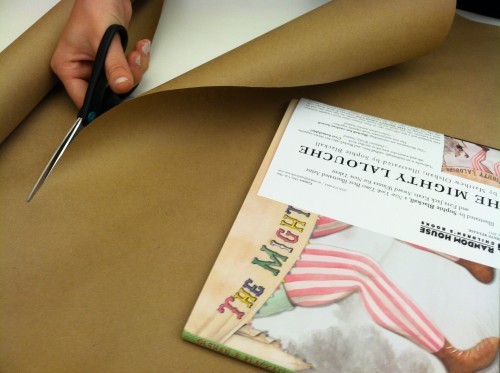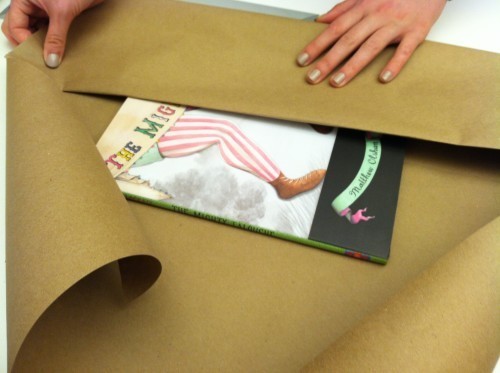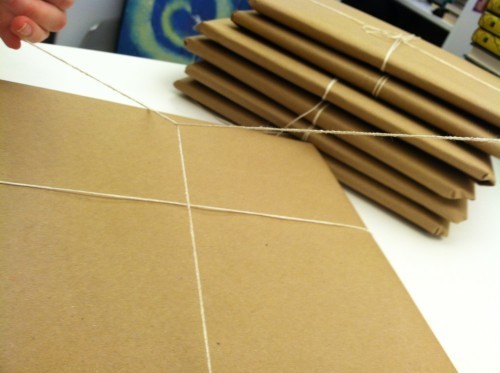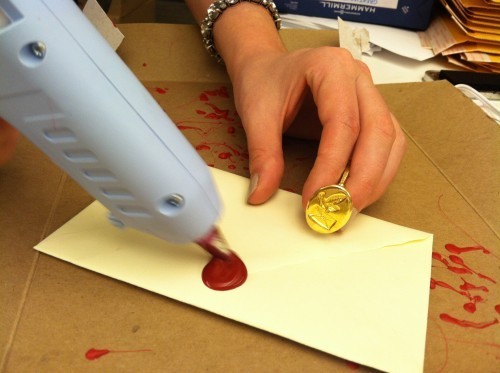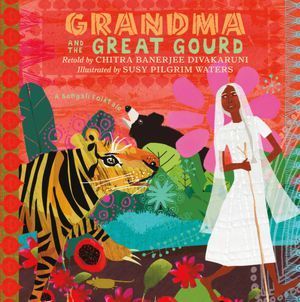Betsy Bird's Blog, page 313
May 14, 2013
The Mighty Lalouche Contest (which I don’t normally do, but this one is sort of too cool to ignore)
A blogger might field any number of requests to host contests for new books on their blogs. And generally speaking, you could be forgiven for almost always politely declining. “No”, you might say, “I just don’t run that sort of blog”. It is the rare book that snaps me out of such a funk as this, and the rare artist who catches my attention fully. Such is the case today with Sophie Blackall and her work on Matthew Olshan’s The Mighty Lalouche.
Best described as a story about French boxing, electric cars, and heroic postmen, Olshan’s text is sublime while Sophie Blackall’s art truly shines. Which brings us to today’s contest. Or, as we like to call it:
HOW TO SEND A HAND-WRAPPED PARCEL
The rules are simple. Share in the comments of this post the BEST package you have ever received in the mail. I’m talking the number one best. Maybe it was a hand tatted doily from your Great-Aunt Gertrude. Maybe it was a live snail named Larry. Maybe it was a flat-screen color TV from somebody you thought died thirteen years ago. Whatever it might be, I want you to tell me about it. Why? Well, after tell me your story a randomly selected winner will receive a hand-wrapped parcel from Sophie Blackall. What might such a package resemble?
Observe. From the woman herself.
Supplies:
Brown Paper
String
Stamps and stamp pads
Scissors
Wax
Glue stick
Stamp for sealing
Step 1: Cut off enough brown paper to cover the front and back of the book and overlap a bit. Parfait!
Step 2: Fold your book into a parcel – just like a Christmas present! My mother always told me to tuck the paper edges under and crease along the seam; it’s more chic this way.
Step 3: Tie your parcel up with string – they didn’t use sticky tape in the 19th Century! See if your friendly baker will give you some of his red and white stripy string. That’s the best kind of string. Super!
Step 4: Decorate your parcel with stamps. If you are going for a classic French look, be restrained with these stamps. If you don’t care, Allez! Stamp away to your heart’s content.
Step 5: Seal the back of your letter with wax. I give you permission to cheat and buy modern wax. It comes sized for glue guns for easy application! Très bien!
Step 6: Slip your letter in the front of the parcel…
VOILA!
(Disclaimer: If you want to send this through the real, modern mail, you’ll need to enclose it in another envelope, otherwise your letter may go astray. Also the Post Office is down on string. Bah!)
Bah indeed. In any case, YOUR package might be even more elaborate than this one. Who’s to say? The woman has a tendency to be artistic.
Now while you ruminate on what your best package of all time was, here is a response I received when I grilled Sophie on why she used the style she did for this book. Here is her answer.
When I sat down to make the first sketches for The Mighty Lalouche, I found my drawings to be frustratingly two dimensional. I wanted to feel you could step into Lalouche’s world. With this book, I was also keen to try something I’d never done before. Being a devil for punishment, I decided to make the book in tatebanko, Japanese paper dioramas. I drew, painted, and cut out thousands of tiny pieces of paper to make Parisian streets and boxing-ring crowds and Lalouche’s cozy apartment. Often, I sneezed and lost a bunch on my studio floor and had to start all over again. I went through many Band-aids. Once the pieces were assembled into scenes, they were lit and photographed. Most pictures books take me around four months to complete; The Mighty Lalouche took nearly two years!
Whew.
All right, time’s up. Tell me your mail based joys and we’ll have a good old-fashioned lovefest for our good brave postal service.
What has truly floated your boat?
May 13, 2013
Review of the Day: Take Me Out to the Yakyu by Aaron Meshon
 Take Me Out to the Yakyu
Take Me Out to the Yakyu
By Aaron Meshon
Atheneum Books for Young Readers (an imprint of Simon & Schuster)
$15.99
ISBN: 978-1442441774
Ages 3-7
On shelves now.
Corner a children’s librarian. Say the words “Japan” and “baseball”. Ask for picture books that involve both topics. What will you get? If I were a betting woman I’d say that nine out of ten librarians would probably hand you a book about America’s Japanese internment camps and the folks in there that played baseball to keep their sanity intact. Baseball Saved Us by Ken Mochizuki or Barbed Wire Baseball by Marissa Moss come immediately to mind. That tenth librarian might go in a different direction, though. Maybe you made it clear that you wanted something contemporary. Something that involves Japanese baseball today, but is written in a style that would engage both the very young and your older, more sophisticated seven-year-old. Until now, you would have been up a tree. Fortunately for all parties, Take Me Out to the Yakyu swoops in to save the day. Visually splendid with a text that manages to be simple without being simplistic, I look at this book and realize that while I’ve nothing else like it on my library shelves, I’d pay all the money in the world for this format to be replicated over and over again. Until that happy day occurs, let’s bask in Meshon’s gift to us.
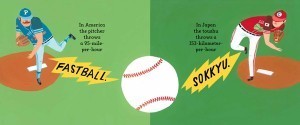 “I love baseball . . . in America . . . and in Japan.” The boy telling us this is a ruddy-cheeked cheery little dickens. In his left hand he holds the red jersey of a Japanese team. In his right, the blue of an American. He then leads us through what it’s like to attend a baseball game with his American pop pop in the States and his ji ji in Japan. Some differences are small. You might take a bus rather than a car to a game in Japan, or you might wear an oversized foam hand rather than toot a giant plastic horn in America. Some differences are fairly large. There’s the food, the different ways of tackling the seventh inning, and even what a fan might buy on their way out. At the heart of it all, though, is the fact that when it comes to baseball, there’s only one real way to close out the day. Lie down on your bed or your mat and think, “What a wonderful day!” A glossary of terms and an Author’s Note are included at the end.
“I love baseball . . . in America . . . and in Japan.” The boy telling us this is a ruddy-cheeked cheery little dickens. In his left hand he holds the red jersey of a Japanese team. In his right, the blue of an American. He then leads us through what it’s like to attend a baseball game with his American pop pop in the States and his ji ji in Japan. Some differences are small. You might take a bus rather than a car to a game in Japan, or you might wear an oversized foam hand rather than toot a giant plastic horn in America. Some differences are fairly large. There’s the food, the different ways of tackling the seventh inning, and even what a fan might buy on their way out. At the heart of it all, though, is the fact that when it comes to baseball, there’s only one real way to close out the day. Lie down on your bed or your mat and think, “What a wonderful day!” A glossary of terms and an Author’s Note are included at the end.
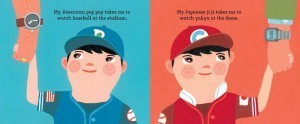 When I review a book for kids I like to include some “readalikes” into the piece for folks looking for similar fare. People looking for picture books that discuss life in contemporary Japan in a style similar to Meshon’s are in luck since there are books like Etsuko Watanabe’s My Japan and Aoki by Annelore Parot out there. Baseball fans, by the same token, could enjoy Ballpark by Elisha Cooper or something a little more esoteric like The Boys by Jeff Newman. Where I get stumped is when I try to think of a picture book that takes a singular event and shows what it’s like alongside that same event in another country. The best I could come up with was Mirror by Jeannie Baker, which shows scenes of daily life in Australia on one page, and Morocco on another. Yet even with Baker’s work there was a mildly unnerving civilized vs. uncivilized vibe about the book that put some readers on edge. Amongst Meshon’s many strengths here is the fact that he really manages to make Japan familiar and unfamiliar all in the same breath. I think part of the reason it works as well as it does is that our hero has been living in both Japan and America for so long that he doesn’t find one style of life or living any better, or more surprising, than another. Japan isn’t exoticized in any way (nor, for that matter, is America). The side-by-side comparisons also have the additional advantage of being just as interesting to American child readers as it would be to Japanese kiddos. No mean feat.
When I review a book for kids I like to include some “readalikes” into the piece for folks looking for similar fare. People looking for picture books that discuss life in contemporary Japan in a style similar to Meshon’s are in luck since there are books like Etsuko Watanabe’s My Japan and Aoki by Annelore Parot out there. Baseball fans, by the same token, could enjoy Ballpark by Elisha Cooper or something a little more esoteric like The Boys by Jeff Newman. Where I get stumped is when I try to think of a picture book that takes a singular event and shows what it’s like alongside that same event in another country. The best I could come up with was Mirror by Jeannie Baker, which shows scenes of daily life in Australia on one page, and Morocco on another. Yet even with Baker’s work there was a mildly unnerving civilized vs. uncivilized vibe about the book that put some readers on edge. Amongst Meshon’s many strengths here is the fact that he really manages to make Japan familiar and unfamiliar all in the same breath. I think part of the reason it works as well as it does is that our hero has been living in both Japan and America for so long that he doesn’t find one style of life or living any better, or more surprising, than another. Japan isn’t exoticized in any way (nor, for that matter, is America). The side-by-side comparisons also have the additional advantage of being just as interesting to American child readers as it would be to Japanese kiddos. No mean feat.
Naturally when someone makes as strong a picture book debut as Take Me Out to the Yakyu, you want to know more about them. Aaron Meshon is interesting because his forays into the book world have been relatively few and far between. A RISD grad (naturally) he did some art for a Brooklyn tour guide once but beyond that I couldn’t find that he’d done much on the publishing end of things. Until now you’d be more likely to find his art in a magazine or on a mural in a Brooklyn coffee bar. His style doesn’t slot into an easy description either (I just deleted a very lame attempt to call it “Hello Kitty meets Adventure Time” which has only the barest ring of truth to it). The colors are used in a clever matter in this story as well. Blue for America and red for Japan, the contrast is killer. The consistency of the color palette is comforting and moves the reader along at a smart and steady clip. There’s the occasional oddity (I’m not sure why our hero’s speech appears as a purple speech balloon with eyeballs during one two-page spread) but it doesn’t distract much. Long story short, what we’ve got on our hands here is a true original. Don’t blink or you might miss it.
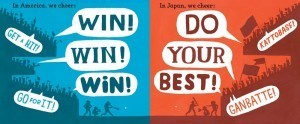 I have a two-year-old that I have turned into a walking litmus test. It is very dangerous to use your own child as a testing ground for books that are way above their reading level/comprehension. My kid does not care about baseball. She’s only just now able to define what a basketball is. As for Japanese culture, that begins and ends with her ability to dissect a sushi roll like she was a surgeon attempting a difficult removal of a kidney stone. That said, she would sit down and listen to every last word of Take Me Out to the Yakyu. Not because the text is babyish, mind. It’s just that Meshon has a singular ability to get to the bloody point. From page one onward you know exactly what this book is about and how the author is going to format it. Then there are the ways in which the author has chosen to incorporate Japanese and American words into the text. Descriptive terms like “Fastball” and “Sokkyu” appear within the pictures themselves, adding life and color. Adults like myself will be interested in hitherto unknown facts like that the Japanese shout terms like “Do your best” at their players (I love that Meshon pairs these essentially positive shouts alongside the very American cheers of “Win! Win! Win!”). Likewise the Glossary of terms and informative section at the end that covers everything from baseball history to game length to mascots will be welcome reading for parents and gatekeepers and interesting for the occasional kid enthusiast.
I have a two-year-old that I have turned into a walking litmus test. It is very dangerous to use your own child as a testing ground for books that are way above their reading level/comprehension. My kid does not care about baseball. She’s only just now able to define what a basketball is. As for Japanese culture, that begins and ends with her ability to dissect a sushi roll like she was a surgeon attempting a difficult removal of a kidney stone. That said, she would sit down and listen to every last word of Take Me Out to the Yakyu. Not because the text is babyish, mind. It’s just that Meshon has a singular ability to get to the bloody point. From page one onward you know exactly what this book is about and how the author is going to format it. Then there are the ways in which the author has chosen to incorporate Japanese and American words into the text. Descriptive terms like “Fastball” and “Sokkyu” appear within the pictures themselves, adding life and color. Adults like myself will be interested in hitherto unknown facts like that the Japanese shout terms like “Do your best” at their players (I love that Meshon pairs these essentially positive shouts alongside the very American cheers of “Win! Win! Win!”). Likewise the Glossary of terms and informative section at the end that covers everything from baseball history to game length to mascots will be welcome reading for parents and gatekeepers and interesting for the occasional kid enthusiast.
To clarify, while I mentioned earlier in this review that there are no picture books quite like Meshon’s out there, that’s not 100% accurate. It’s true that there are no simple picture books of a kiddo living in Japan and America that compare. There are, however, books that have taken the format of two different homes brought together for side-by-side comparisons and applied it to other situations. I’ve seen this happen in books about divorce like Living with Mom and Living with Dad by Melanie Walsh, and I’m sure there are stories about visiting different grandparents, or what people do in Latin American vs. United States households. That said, for sheer appeal, Meshon stands out. Basically what you have here is a book that is so amusing that the fact that it also happens to teach interesting facts is almost beside the point. Kids will gravitate to this book because the art looks like fun, the text is really amusing, and it’s about baseball. And if they happen to learn a ton about Japanese culture along the way? Bonus. A necessary purchase them. For sports fans and seekers of multicultural fare alike.
On shelves now.
Source: Final copy sent from publisher for review.
Like This? Then Try:
My Japan by Etsuka Watanabe
Ballpark by Elisha Cooper
Aoki by Annelore Parot
Mirror by Jeannie Baker
Videos: A remarkably successful book trailer, if I do say so myself.
May 12, 2013
Video Sunday: The Happy Mother’s Day Edition (Warning: Contains no mom-related material)
Happy Mother’s Day!
It was Monica Edinger who alerted me to the fact that fresh on the heels of the Matilda musical is an upcoming British production of Charlie and the Chocolate Factory. She has the details and directed me to this truly unfair let’s-not-give-anything-away teaser trailer.
This introduction is a bit better.
You know what this means, don’t you? We are just THIS MUCH CLOSER to a truly terrifying Witches musical. And I’ll be first in line. Thanks to Monica for the link!
Last weekend I hosted author Sue Stauffacher at my Children’s Literary Salon at NYPL to talk about her Wireman series. If you’re unfamiliar with the books, they’re essentially graphic novels containing the 100 most common words for kids and teens with low reading comprehension. The art is stellar, it’s a brilliant reading tool, and there’s nothing like it out there. It also doesn’t have a publisher at the moment *ahem hem*. In any case, check out this pitch from Eric, a student at the Detroit Palmer Park Preparatory Academy. Love that kid’s style.
Sometimes it feels like SLJ reporter Rocco Staino has wings on his heels the way he flits about the world, capturing all the good stories. Now it appears he’d also do well on Sesame Street. Talk about a natural rapport with a puppet! Well played, man.
Book trailer time! This one’s a delight. It’s The Tribe: Homeroom Headhunters by Clay McLeod Chapman and it’s a good example of how to make a simple but effective trailer. Love that Vertigo effect too.
Then, a switch of gears. This one is for Listen to the Birds: An Introduction to Classical Music by Ana Gerhard, illustrated by Cecilia Varela. Sweet sweet public domain music.
Now there’s much to love of this Lunch Lady video featuring actual lunch ladies dancing, as you can see:
However, I think the point we should be careful not to miss is that this song is sung by Recess Monkey, the band. An actual band. Not a bad idea in the least.
And finally, for our off-topic video (which also has nothing to do with Mother’s Day in the slightest) it’s what we all had hoped for. A stage music of the fourth season of Downton Abbey. I’ll be humming the Tea Song for the rest of the day, I think.
May 10, 2013
2013 Middle Grade Black Boys: Seriously, People?
So I’m in the office talking with my colleagues about A Girl Called Problem by Katie Quirk and how awesome it is. Then the topic shifts to books with African-American protagonists published in 2013 for kids between the ages of 9-12. You know. Middle grade fiction. And in the midst of my lamenting how few African-American girl protagonists I’ve seen in 2013 it hits me. Yeah, I’ve seen few girls, but I’ve seen pretty much ZERO boys.
I run through my mental database and the results are not good. I’ve read approximately fifty-one middle grade novels for 2013 by this point. Of these, one starred an African-American male character (Etched in Clay by Andrea Cheng). Of the other books, I’ve seen quite a few black girls as either the hero’s friend or as the hero herself. And I have seen ZERO ZERO ZERO African-American boys. Like, zip.
COME ON, PEOPLE!!! Seriously now. Is the rule that we can’t let anyone besides Greg Neri and Walter Dean Myers write middle grade fiction with boys? Is no one writing anymore? What is the friggin’ deal?
After venting my venom at Twitter I got a couple suggestions. Some were YA, some early chapter fare (though I am seriously gonna grab that Karen English book Dog Days the minute it gets within my periphery), a picture book here, an adult novel there. Here then is a complete list, insofar as I can tell, of ALL the books starring African-American boys in middle grade fiction for 2013. Don’t blink or you might miss it.
Etched in Clay: The Life of Dave, Enslaved Potter and Poet by Andrea Cheng
The Cruisers: Oh, Snap! by Walter Dean Myers
STAT: Standing Tall and Talented: Slam Dunk by Amar’e Stoudemire
STAT: Standing Tall and Talented: Schooled by Amar’e Stoudemire
Streetball Jammers: Sasquatch in the Paint by Kareem Abdul-Jabbar
That’s all she/he wrote, folks.
I have the sense that there’s an obscure historical middle grade from a very small publisher that I’m forgetting here. Otherwise, it appears that unless you’re writing about history, you’re Walter Dean Myers, or you’re a basketball star / former basketball star, you simply cannot get a middle grade book about black boys out there. Sorry to be a debbie downer but this is something we friggin’ need to talk about. Full credit, by the way, to the publishers listed here that actually ARE publishing something. Imagine if they weren’t.
Please for the love of all that’s good and holy, tell me what I’m missing. If you’re hiding a full cache of these books somewhere (or you know of some awesome fall releases that are unknown to me) I’d love to hear it.
May 9, 2013
Here’s to You, Mrs. Berenson
Yesterday I had the very great pleasure of sitting down with author Dr. Chitra Divakaruni, illustrator Susy Pilgrim Waters, and their editor Neal Porter. You may be aware of the remarkable collaboration these clever folks have concocted. The book is called Grandma’s Great Gourd and it’s a Bengali folktale of unparalleled loveliness.
Ms. Divakaruni is quite the author in the adult book world (you may have heard of her Oleander Girl) and it is a pleasure to see folktales from her. While speaking, she told me that she owed a turning point in her life to librarians. I asked to hear her story and she has kindly allowed me to print it here. Since it involves a Chicago librarian I think it’s a great tie-in to the upcoming ALA. It makes me think of my Chicago librarian peeps out there like Julie Jurgens who blogs at Hi, Miss Julie,Eti Berland, and Heather and Jennifer Norborg.
For the librarians.
Here’s To You, Mrs. Berenson
By
Chitra Divakaruni
It was a blustery evening in Chicago, the sky colored like slate. As I waited for the bus, my eyes watered in the bitter, biting wind that was colder than I had ever imagined wind could be. The cold pierced through my bright orange coat—a coat that I’d bought with high hopes in Calcutta, my hometown, just a month ago. There, friends had exclaimed over its cheery brightness in admiration. Here, the few people waiting at the bus stop (dressed in sober browns and blacks) eyed it—and the sari I wore under it—with silent suspicion.
Finally, the bus appeared around the corner, its doors wheezing open. I climbed in and sank into a seat thankfully. The toddler whom I babysat had been cranky all day. At dinner, he had thrown his bowl of spaghetti-and-sauce at me, ruining my sari. When I’d remonstrated, he promptly flung himself onto the floor and indulged in a tantrum. A long one. But at least it was over. Soon I’d be at the apartment where I was staying with relatives. In a few hours, after dinner and dishwashing and comedy shows on TV with indecipherable jokes, I’d be able to pull out the sofa-bed and crawl into it.
Just then the bus shuddered to a stop. The engine rattled loudly. This was followed by an ominous silence. The driver fiddled with various mechanisms. Then he announced that the engine was dead. We would have to get down and wait for the next bus.
Hunched in my orange coat which miserably failed to keep out the freezing wind, I followed the others down the sidewalk. Maybe, I thought as I trudged along, coming to America had been a mistake. Maybe I should give up on my dreams of higher studies and go back. Agree to an arranged marriage like my cousin had done.
Then I saw the small building with its brightly lit glass walls, the American flag in front, the sign on the wall. Library, it announced. It looked so warm inside, I couldn’t resist, even though I knew I’d get late, that my relatives would worry. I walked in a little fearfully. In libraries back home, you had to buy a membership before you were allowed to sit at the reading tables or check out the two books each patron was allowed. And I had no money to spare.
But here no one stopped me. The woman at the desk—an older lady in a cardigan with her white hair pinned back in a neat bun–gave me a welcoming nod. I walked past her to the stacks filled with books, breathing in their unique smell. It struck me that I hadn’t been in a library ever since I’d arrived in America. I hadn’t read a single book.
I came back to the desk and asked the woman—a tag pinned to her cardigan said, A. Berenson, Librarian—if I could borrow a book. She asked me if I had identification. I produced it. She typed out a card with my name on it. It was that simple. When I asked her how many books I could borrow, she said, “As many as you can carry out! What are you looking for?”
There was such genuine interest in her voice, that I was emboldened to confide to her a dream that seemed to be slipping further from my grasp each day.
“I want to go to graduate school and study American Literature,” I whispered.
I had expected a look of disbelief, perhaps even pity. But she nodded as though what I said was entirely possible. She took me to the stacks where she paused, considering carefully, then handed me a book. The Great Gatsby, the title proclaimed. I had never heard of it, but already I trusted Mrs. Berenson. She picked out several other books. When I walked out of the library, hugging their sweet weight, the night had grown warmer. Or was the warmth inside my heart?
That night I opened The Great Gatsby and plunged into a fascinating world of affluence and excess, of desire and disappointments. My own problems receded as I participated in Gatsby’s drama and waited tensely to see if he would find love. I stopped reading only when exhaustion forced my eyes shut.
I took the book to work the next day and read it in between my duties. When my young charge threw his usual tantrum, I ignored him and kept reading. This novel response astonished him into silence. In three days, I’d finished the book. I took it back to Mrs. B, and expressed to her my outrage that Gatsby had been killed, that fiction could be as unfair as life. She listened with her calm smile, then said, “But it’s made you care. It’s made you want to do something about such things, if you get a chance. Isn’t that more important?”
I’d never thought about reading in that way before. A small, very small thought flashed in my mind for a moment: I’d like to write like that someday. Outrage my readers. Make them care. Make them do something about injustice.
Over the next months, Mrs. B gave me many other books. Native Son. The Woman Warrior. Sister Carrie. The Turn of the Screw. My Antonia. Fahrenheit 451. The Adventures of Huckleberry Finn. Cat’s Cradle. Bless me Ultima. After I finished each one, she took time to listen to my responses. And in between, “because fun is important,” she introduced me to her favorite singers, from Billie Holiday to Simon and Garfunkel
Something happened to me in those months that I can’t explain. Though my outer circumstances hadn’t changed, my attitude was different. Perhaps it was because Mrs. B took my opinions seriously and encouraged me to think large. Perhaps it was that she chose for me books where characters struggled, like me, to achieve the American Dream—often under circumstances far worse than mine. Maybe it was the spirit of the songs I listened to on the portable cassette player she had loaned me: a spirit full of hope and compassion and joyfully aware of the fragility and beauty of human life. In any case, I became determined that I wouldn’t give up. I saved my salary, studied seriously each night, took the required exams, got accepted into college, put aside my pride and borrowed money for relatives to pay my fees. I got one degree and then another. I married, moved across the country, had children, started teaching, and slowly, tentatively, began to write. In all the busyness of my life, Mrs. Berenson slipped into the cracks of my memory.
Years later, when my first book of stories was published, I walked into our local library—a place my children loved as much as I did—and went to the stacks. There it was, nestled between Dickinson and Dybek: Arranged Marriage, by Chitra Divakaruni. I had to touch it to make sure it was real. And suddenly I was in that other library, those other stacks, and Mrs. B was smiling at me, handing me The Great Gatsby. A song she’d loved flowed through my mind, the words molding themselves to fit what I felt, what I never got a chance to tell her: God bless you please, Mrs. Berenson, I owe you more than I can ever say. And then, because fun is important: Hey, hey, hey.
https://www.facebook.com/chitradivaka...
http://www.chitradivakaruni.com/books...
May 7, 2013
Press Release Fun: Hip Tot Music Fest
What does this have to do with children’s literature? Oh ye of little faith. Read on everything shall be revealed to you. It’s right there in the fourth paragraph, bright and shiny and new. I’m so pleased and proud. Many many thanks to Melanie for inviting me in the first place.
FOR IMMEDIATE RELEASE
PLAID IS ALL THE RAGE FOR THE UNDER 7 CROWD!
Hip Tot Music Fest Welcomes the Ska Sounds of
The Trummytones for Mother’s Day
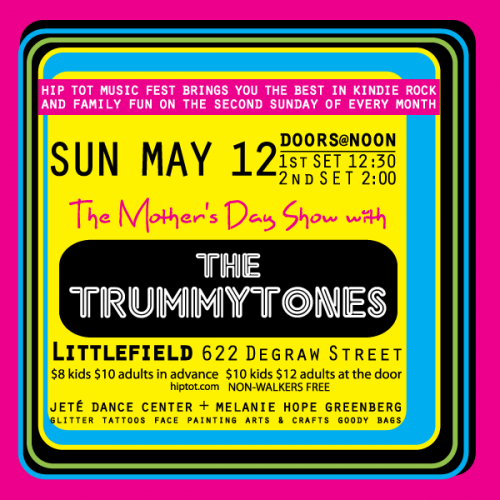
HIP TOT MUSIC FEST will be hosting its first Mother’s Day show on Sunday, May 12th with The Trummytones, a skanking pop zydico reggae kindie band. Doors open at noon and the band will perform two sets, one at 12:30 and one at 2:00. The show opens with a story read by Author/Illustrator Melanie Hope Greenberg and there is a fun intermission show featuring the students of Jeté Dance Center.
The Trummytones are an exciting new children’s music band led by world-renowned trombonist and front man Vinny Nobile (Bim Skala Bim, Pilfers). The Trummytones fuses tuba, drums, accordion, and Vinny’s high-energy performance into an organic acoustic pop zydico and reggae fun for all ages.
The Trummytones are perennial favorites performing for the “musicon the menu” series in the Greenwich Public Schools where entertainment and education meet. When the Stepping Stones Children’s Museum needed music for their annual beach party they called on the The Trummytones and the kids danced the night away! The summer of 2012 saw The Trummy tones headlining the children’s stage at The Gathering Vibes Festival and the Greenwich Town Party warming up for Dave Mathews and Paul Simon.
A surprise addition to this show, Amelia Robinson, creator of Mil’s Trills, will be joining the Trummytones on stage with her supersonic electric ukulele. If we are lucky we might even get a song or two from the quirky Brooklynite whose incredible voice takes you to era of the past.
Along with our house author/illustrator Melanie Hope Greenberg, this month we have special guest Betsy Bird reading her book Giant Dance Party! Betsy is New York Public Library’s Youth Materials Specialist. She blogs about children’s literature regularly at A Fuse #8 Production and has reviewed professionally for Kirkus, TimeOut Kids New York, and The New York Times. Betsy is the author of Children’s Literature Gems: Choosing and Using Them in Your Library Career and a book about the true stories behind children’s books due out with Candlewick in Fall 2013.
Hip Tot is welcoming back local artist Monica Rodriguez. Monica takes found objects and collages them in brightly colored recycled paper. The results are extraordinary! Brilliant colors with somewhat recognizable objects that you just want to love. Monica will be creating traditional Mexican tissue flowers with the kids to give to mom.
Both resident parent-photograpers will be on hand at this month’s show to capture all the fun. Beth Eisgrau-Heller, mom to one super cute lil guy, comes to us with experience in music in all forms. From her involvement with Willie Mae Rock Camp for Girls, to vocalist, to event coordinator to photographer for KEXP radio, Beth understands the ins and outs of photographing a music performance. Our portrait photo artist, Edward Kay, brings his incredible still life photography talent to our vivacious photo booth! Edward’s photos can be purchased on his website at edwardkphoto.com
Hip Tot producers Gabby and Adam have worked hard to create an incredible community for families, which includes activities, snacks, music and more. Hip Tot Music Fest is famous for the best live Kindie music, complete with story time, mid-show entertainment, craft activities, a cardboard castle, giveaways and photo station. Hip Tot is like no other family show!
“I was thrilled to experience such a strong community event that is focused on music, creativity, and staying hip.” - Mama Goes Natural
See you on Sunday, May 12th ready to celebrate Mother’s Day with music, stories, dance, art and fun!
About Hip Tot Music Fest
The family-centric Hip Tot Music Fest is a series of live performance and music concerts for families at state-of-the-art performance and art space Littlefield in Brooklyn. Co-produced by Adam Meyer and Gabby Napolitano, Hip Tot Music Fest brings family and community merchants together with live performance for a true fest. Pre-show entertainment includes well known childrens’ author Melanie Hope Greenberg, local dance troupe The Jeté Dance Center, arts and crafts and snacks.
For more info: www.HipTot.com
LIKE us on Facebook: http://www.facebook.com/hiptotmusicfest
follow us on Twitter@hiptotmusicfest
view us on instagram @hiptot #HipTot
Review of the Day: Cowboy Up! Ride the Navajo Rodeo by Nancy Bo Flood
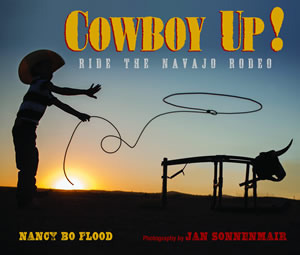 Cowboy Up!: Ride the Navajo Rodeo
Cowboy Up!: Ride the Navajo Rodeo
By Nancy Bo Flood
Photography by Jan Sonnenmair
Wordsong (an imprint of Highlights)
$17.95
ISBN: 978-1-59078-893-6
Ages 8-12
On shelves now
Sometimes I think half my job simply consists of making lists. Not that I’m complaining. I love lists. I love making them, and checking them, and adding to them. Lists let the organizational part of my frontal lobe feel needed and wanted. Still, once in a while you get stuck on a list and it’s hard to move. For example, just the other day I was asked to come up with a list for Kindergartners of books that talk about Native American tribes. Some of the books, I was told, would also have to talk about American Indians living today. Now I don’t know anything about you. I don’t know if reading this review you’re a teacher or a librarian or an interested parent or my mom. Whosoever you might be, you are still probably very aware that asking for nonfiction titles for very young children on Native Americans is akin to asking for the moon and the stars above. Half the stuff on library and bookstore shelves is woefully out-of-date and offensive while the other half is written for kids ten-years-old and up. The pickings for small fry are slim. Enter Cowboy Up! Ride the Navajo Rodeo. The rare book that is both poetry and fact, with content for both big and little, here we have a title that finally fills that gap. Best of all, you don’t have to be looking for school or specialty fare to enjoy this one. Like wild bucking stallions and bulls that could impale you without so much as a snort? Welcome to the world of Navajo rodeo.
 “Can’t sleep. Can’t eat. Mind keeps figuring, figuring, figuring – how tight to hold, how far to lean, how hard to squeeze to stay on top.” That’s just a sample of the thoughts going through a person’s head before the Navajo rodeo. Though it has its roots in places like Arizona and Texas, rodeos can be found all over the Navajo Nation and are family affairs. Setting her book during the course of a single rodeo day, author Nancy Bo Flood plunges readers into what might be an unknown world. We see children near bucked from woolly riders (sheep), adults flung from broncos, women who sweep the barrel racer events, steer wrestlers, and, best of all, bareback bull riders. Saturating her text with facts, background information, and tons of photographs, this is one title that will prove tempting to kids already familiar with the rodeo world and those approaching it for the very first time.
“Can’t sleep. Can’t eat. Mind keeps figuring, figuring, figuring – how tight to hold, how far to lean, how hard to squeeze to stay on top.” That’s just a sample of the thoughts going through a person’s head before the Navajo rodeo. Though it has its roots in places like Arizona and Texas, rodeos can be found all over the Navajo Nation and are family affairs. Setting her book during the course of a single rodeo day, author Nancy Bo Flood plunges readers into what might be an unknown world. We see children near bucked from woolly riders (sheep), adults flung from broncos, women who sweep the barrel racer events, steer wrestlers, and, best of all, bareback bull riders. Saturating her text with facts, background information, and tons of photographs, this is one title that will prove tempting to kids already familiar with the rodeo world and those approaching it for the very first time.
It’s a challenge facing any work of standard nonfiction for kids: How do you prefer to present your material? In this particular case, Ms. Flood has a wealth of information at her fingertips regarding the Navajo rodeo circuit. Trouble is, you can fill your book to brimming with the brightest and shiniest photos that money can buy, but if you’ve long blocks of nonfiction text you might lose your readership before you’ve even begun. Now in this book Ms. Flood presents her material over the course of a single rodeo day. It’s a good format for what she has to say, but the downside is that there are sections at the beginning that aren’t all that thrilling. If kids are coming to this book to see some high-flying riders, they’ll have to first wade through explanations about the announcer and the arena. That’s where the poetry comes in. Sure, there are big blocks of explanatory text before the action begins, but Flood tempers each two-page spread with not just photos and explanations but also poems. The advantage then is that younger children can read the poems while older ones get something out of the nonfiction sections. Win win!
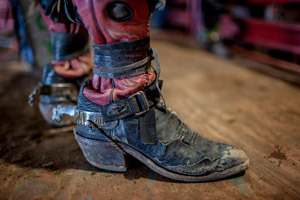 It sounds strange to say but in many ways the book that to me feels the closest to the format of Cowboy Up! is Good Masters! Sweet Ladies!: Voices from a Medieval Village by Laura Amy Schlitz. Both books find that the best way to get kids to swallow a spoonful of nonfiction is with a bit of first person narration. With that in mind, the poems in Cowboy Up! offer great promise. Each one is written in the first person and could easily be considered short monologues. The small child auditioning or the teacher who wants to do a theatrical presentation with readily available material would do well to take these poems and use them freely. Now granted, the poetry can be touch-and-go at times. I’ve a friend who personally cannot stand free verse in children’s books because to her it just looks like the author took a paragraph and broke it up into arbitrary lines. I happen to like free verse, insofar as I like any poetry, but I admit that the ones found here varied widely in terms of quality on a case-by-case basis.
It sounds strange to say but in many ways the book that to me feels the closest to the format of Cowboy Up! is Good Masters! Sweet Ladies!: Voices from a Medieval Village by Laura Amy Schlitz. Both books find that the best way to get kids to swallow a spoonful of nonfiction is with a bit of first person narration. With that in mind, the poems in Cowboy Up! offer great promise. Each one is written in the first person and could easily be considered short monologues. The small child auditioning or the teacher who wants to do a theatrical presentation with readily available material would do well to take these poems and use them freely. Now granted, the poetry can be touch-and-go at times. I’ve a friend who personally cannot stand free verse in children’s books because to her it just looks like the author took a paragraph and broke it up into arbitrary lines. I happen to like free verse, insofar as I like any poetry, but I admit that the ones found here varied widely in terms of quality on a case-by-case basis.
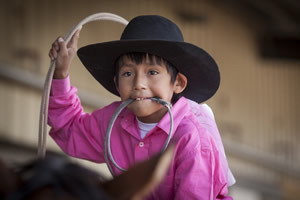 Much like the poetry, the photography in this book can vary. Some of the shots (created by photographer Jan Sonnenmair) are brilliant. I’m quite fond of the image on the jacket as well as shots of riders mid-air (one hand waving freely about their heads), the portraits (love those endpapers, though the decision to flips the images was a poor one when you consider library processing techniques), and even one of a rainbow rising behind the honor guard. On the other hand, there are times when it feels as though the book ran out of the good photographs and had to rely on some of the lesser variety. For example, there’s a shot of an announcer that looks like it appears twice in two pages, only flipped. This is a rare occurrence, but it happens early enough in the book that a reader could be forgiven for wondering if more duplication is bound to happen.
Much like the poetry, the photography in this book can vary. Some of the shots (created by photographer Jan Sonnenmair) are brilliant. I’m quite fond of the image on the jacket as well as shots of riders mid-air (one hand waving freely about their heads), the portraits (love those endpapers, though the decision to flips the images was a poor one when you consider library processing techniques), and even one of a rainbow rising behind the honor guard. On the other hand, there are times when it feels as though the book ran out of the good photographs and had to rely on some of the lesser variety. For example, there’s a shot of an announcer that looks like it appears twice in two pages, only flipped. This is a rare occurrence, but it happens early enough in the book that a reader could be forgiven for wondering if more duplication is bound to happen.
When I think of books that talk about contemporary Native Americans today, the pickings for kids are slim. The Absolutely True Diary of a Part-Time Indian isn’t exactly meant for the 12 and under crowd. Walking on Earth and Touching the Sky is pretty good, if a bit poetic (this might have something to do with the fact that it’s a book of poetry). And the book Native Americans: A Visual Exploration by S.N. Paleja covers a lot of ground, but only in brief. No, the whole reason Cowboy Up! even works is because it’s not trying to be about anything but how particularly cool this kind of rodeo is. This is Navajo life in the 21st century. So forget depressing texts that cover the past with all the interest of a phone book. Flood and Sonnenmair have culled together a look at the just-as-interesting present, and given it a format that will stand it in good stead. Cowboys and cowboys-to-be everywhere, stand up and rejoice. Your rodeo is here.
On shelves now.
Source: Final copy sent from publisher for review.
Like This? Then Try:
Bill Pickett: Rodeo-Ridin’ Cowboy by Andrea Davis Pinkney, ill. Brian Pinkney
Good Masters! Sweet Ladies! Voices from a Medieval Village by Laura Amy Schlitz, ill. Robert Byrd
Walking on Earth and Touching the Sky: Poetry and Prose by Lakota Youth at Red Cloud Indian School. Edited by Timothy P. McLaughlin. Illustrated by S. D. Nelson.
Bull Rider by Suzanne Williams
The Cowgirl Way: Hats Off to America’s Women of the West by Holly George-Warren
Professional Reviews: Kirkus
Interviews: ReaderKidz
Misc:
A lesson hard learned. When searching for this book on any online site, I advise you to search via the ISBN 978-1-59078-893-6 rather than typing in the words “Cowboy Up”. Let’s just say that the bulk of titles you’ll find with the same title are a bit . . . ah . . . saucy.
Download a free activity guide here.
May 5, 2013
Press Release Fun: The 19th Annual Children’s Book Art Auction
The 19th Annual Children’s Book Art Auction has been a highlight of children’s programming at BookExpo America and raises funds in support of the free speech rights of young readers. This event offers a unique opportunity to buy beautiful, original art in children’s literature from leading, award-winning artists and illustrators of children’s books and a chance to socialize with friends from around the country, while supporting the all-important efforts opposing the censorship of children’s books and authors nationwide. This is a highly anticipated and fun event on the industry’s social calendar, and the only annual event where the entire children’s book industry is in the same room, including booksellers, publishers, authors, artists, illustrators, other industry professionals, and fans of illustrated children’s books and supporters of the free speech rights of young readers.
The event will be held on Wednesday, May 29, 2013 from 5:30pm to 7:30pm in the River Pavilion of the Jacob K. Javits Convention Center in New York City in conjunction with BookExpo America. Proceeds will support the American Booksellers Foundation for Free Expression’s defense of the free speech rights of young readers. ABFFE is a co-founder of the Kids’ Right to Read Project (KRRP) and a principal sponsor of Banned Books Week, the only national celebration of the freedom to read.
The event is shaping to be a really fun event: Bestselling authors Jack Gantos and Lauren Myracle are co-hosting, many of the illustrators will be in attendance, there will be a live auction, a special tribute to the late Maurice Sendak will feature pieces created by children’s book illustrators in honor of Sendak, who mentored and inspired many artists. A special auction area will be devoted to the items. Check out some of the Sendak-inspired artwork that has arrived so far. We’re announcing today that we’ve acquired an actual, original, signed sketch by Sendak! There will be food, drinks, raffle items, a couple of bookish-related photobooth props, and more.
In addition to the auction website, we’re promoting it on Flickr, Facebook and Pinterest. Most of the art is already online (I’m working as fast as I can to get the rest up!) We just got a great article and slideshow in today’s Huffington Post.
VOLUNTEERS NEEDED: We’ll be setting up all day on Wednesday, May 29 at the Javits Center, the event itself is that evening from 5:30 – 7:30pm, then break-down will probably last about an hour or so. What does your schedule look like that day? We’ll have you for any and all! We’re going to need a set-up crew, greeters, ticket checkers, raffle ticket sellers, photographers, art monitors, tweeters, a break-down crew, and a whole lot more. For more info, please visit http://abffesilentauction.wordpress.com/volunteer/. For questions or to volunteer, please contact the auction’s manager, Kristen Gilligan Vlahos at kristen@abffe.org.
ONLINE AUCTION OPEN TO PUBLIC: Please be sure to check out the online auction just prior to BEA with different art. It begins on Saturday, May 18 at 9am and closes on Friday, May 24 at 9pm. It can be found here: http://myworld.ebay.com/abffe. It’s open to the public, so feel free to spread the word.  For more info, please visit the auction’s website.
For more info, please visit the auction’s website.
May 3, 2013
Fusenews: Truncated Edition
My little sister Kate (who has taken it upon herself to become the best friend a picture book author ever had) created this little video of my recent appearance at the Bookbug bookstore in Kalamazoo, Michigan. I’ll be doing a proper write-up of that day (two words: smoke machine) but for now here’s a taste of what you might see if you headed on over to the WORD Bookstore this Sunday at 1:30. I may even show up this time. Bonus!
By the way, my fantastically talented illustrator Brandon Dorman just wrote a piece for the Greenwillow blog that offers a behind-the-scenes look at the early and preliminary images he created for Giant Dance Party. Like process? Like art? This post’s for you.
In other news, I’m moderating a free (f-r-e-e, folks) webinar for the good folks here at SLJ. Called Books for Kids: Spring Reading for Growing Minds the event is on Tuesday, May 14th from 3-4 ET. Here’s a quickie description:
Are you ready for an adventure? With beautiful illustrations, imaginative journeys, and timeless lessons, a great children’s book captures the hearts and minds of all generations. Whether you’re looking for the perfect book to fit in with the Common Core State Standards or you’re just looking to spice up story time, this free webcast is for you. Join Groundwood Books, Teacher Created Materials, and Random House Inc. as they present the best new upcoming books for kids from Shell Education, Archie Comics, National Geographic for Kids, Blue Apple Books, and Quirk Books.
Sign-up today!
Aw heck. It’s just that kind of day. Planning on coming to BEA? Then check out the autographing roster. Then figure out when I’m signing and come keep me company. My nightmare is that they put me next to someone like Mo Willems and I stare at an empty sea of nothingness while he manages thousands of rabid fans. Maybe the seating will be alphabetical. That would be okay. Just no Willems, dear god, no Willems.
Now let’s keep it within the family. You may know that the remarkable children’s book editor Cheryl Klein has a regular podcast with her squeeze James Monohan. For those who would seek it out it’s called The Narrative Breakdown. Well my own squeeze, Matt Bird (he of the smart-as-a-whip blog Cockeyed Caravan) is on their latest episode. The topic? The Power of Irony. You’re going to have to check it out, I’m afraid. It’s your required listening of the day.
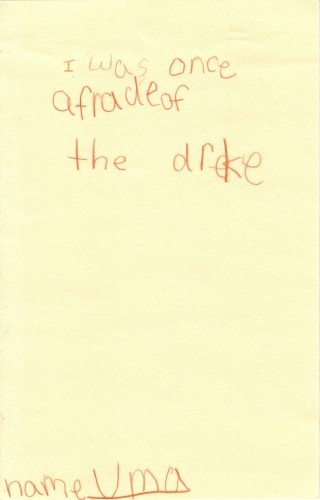 You have seen children’s fan letters before. You may also have read my recap of what happened when Lemony Snicket, Jon Klassen, and Neil Gaiman all shared a stage together at Bank Street. But you have NOT seen the honest-to-goodness hilarious (there is no other way to describe them) “fan” letters sent to the attendees. Gold, guys. These things are gold. My favorite is the one that shows two stick figures, and one of them is reclining and eating what is clearly a shiny red apple. Thanks to Allie Bruce for the link!
You have seen children’s fan letters before. You may also have read my recap of what happened when Lemony Snicket, Jon Klassen, and Neil Gaiman all shared a stage together at Bank Street. But you have NOT seen the honest-to-goodness hilarious (there is no other way to describe them) “fan” letters sent to the attendees. Gold, guys. These things are gold. My favorite is the one that shows two stick figures, and one of them is reclining and eating what is clearly a shiny red apple. Thanks to Allie Bruce for the link!It was with a heavy heart that I learned about the recent death of Gregory Rogers, author illustrator, and Australia’s first Kate Greenaway Medal winner (for Way Home by Libby Hathorn). Of course my favorite books of his were The Boy, the Bear, the Baron and the Bard and Midsummer Knight . I only met him briefly when he was in New York, but he was a charming fellow. Godspeed.
Mentioning to you a Kickstarter campaign to promote a library podcast that has already reaching its primary funding goals sounds a bit odd, but I have my reasons. You see, one of the rewards on offer is a piece of commissioned artwork by Tom Angleberger, the author of the Origami Yoda series. Tell me you wouldn’t want a piece of that!
Daily Image:
Not much more to say about this next one except that it combines two of my favorite things: robots and librarians. Now THERE’s a picture book idea.
Now someone go get me a pair of her shoes.
Culled from the Flavorwire post 25 Vintage Photos of Librarians Being Awesome.
May 2, 2013
Review of the Day: A Girl Called Problem by Katie Quirk
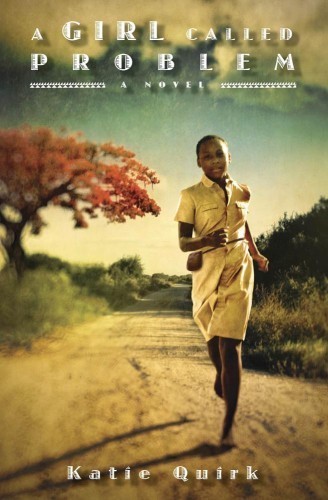 A Girl Called Problem
A Girl Called Problem
By Katie Quirk
Eerdmans Books for Young Readers
$8.00
ISBN: 97800-8028-5404-9
Ages 9-12
On shelves now.
Who says that mystery novels for kids all have to include the same tropes and settings? I tell you, half the time when a kid comes up to a reference desk asking for a mystery they think what they want is the standard white kids in suburbia model perfected by Encyclopedia Brown and his ilk. They’re wrong. What they really want is great writing and a good mystery with a twist they don’t see coming. So I will hereby give grand kudos and heaping helpfuls of praise to the librarian/bookseller/parent who hears a kid ask for a mystery and hands them Katie Quirk’s A Girl Called Problem. This book is a trifecta of publishing rarities. A historical novel that is also a mystery set in a foreign country that just happens to be Tanzania. Trust me when I say your shelves aren’t exactly filled to brimming with such books. Would that they were, or at the very least, would that you had as many good books as this one. Smart commentary, an honestly interesting storyline, and sharp writing from start to finish, Quirk quickly establishes herself as one author to watch.
The thing about Shida is that in spite of her name (in Swahili it would be “problem”) you just can’t get her down. Sure, her mom is considered a witch, and every day she seems to make Shida’s life harder rather than easier. Still, Shida’s got dreams. She hopes to someday train to be a healer in her village of Litongo, and maybe even a village nurse. In light of all this, when the opportunity arises for all of Litongo to pick up and move to a new location, Shida’s on board with the plan. In Nija Panda she would be able to go to school and maybe even learn medicine firsthand. Her fellow villagers are wary but game. They seem to have more to gain than to lose from such a move. However, that’s before things start to go terribly wrong. Escaped cattle. Disease. Even death seems to await them in Nija Panda. Is the village truly cursed, just unlucky, or is there someone causing all these troubles? Someone who doesn’t want the people of Litongo there. Someone who will do anything at all to turn them back. It’s certainly possible and it’s up to Shida to figure out who the culprit might be.
The trouble with being an adult and reading a children’s work of mystery fiction is that too often the answer feels like it’s too obvious. Fortunately for me, I’m terrible at mysteries. I’ll swallow every last red herring and every false clue used by the author to lead me astray. So while at first it seems perfectly obvious who the bad guys would be, I confess that when the switcheroo took place I didn’t see it coming. It made perfect sense, of course, but I was as blindsided as our plucky heroine. I figure if I honestly as a 35-year-old adult can’t figure out the good guys from the bad in a book for kids, at least a significant chunk of child readers will be in the same boat.
Now I’ve a pet peeve regarding books set in Africa, particularly historical Africa, and I was keen to see whether or not Ms. Quirk would indulge it. You see, the story of a girl in a historical setting who wants to be a healer but can’t because of her gender is not a particularly new trope. We’ve seen it before, to a certain extent. What chaps my hide is when the author starts implying that tribal medicines and healing techniques are superstitious and outdated while modern medicine is significantly superior. Usually the heroine will fight against society’s prejudices, something will happen late in the game, and the villagers will see that she was right all along and that she’ll soon be able to use Western medicine to cure all ills. There’s something particularly galling about storylines of this sort, so imagine my surprise when I discovered that Quirk was not going to fall into that more than vaguely insulting mindset. Here is an author unafraid to pay some respect to the religion of the villagers. It never dismisses curses but acknowledges them alongside standard diseases. Example: “Though Shida was certain Furaha should take medicine for malaria, she was equally certain she should guard the spirit house that night. Parasites were responsible for some sicknesses and curses for others, and in this case, they needed to protect against both.”
Quirk is also quite adept at using the middle grade chapter book format to tackle some pretty complex issues. To an adult reading this book it might be clear that Shida’s mother suffers from a severe form of depression. There’s no way the village would be prepared to handle this diagnosis, and Shida herself just grows angry with the woman who stays inside all the time. You could get a very interesting book discussion going with child readers about whether or not Shida should really blame her mother as vehemently as she does. On the one hand, you can see her point. On the other, her mother is clearly in pain. Similarly well done is the final discussion of witches. Quirk brings up a very sophisticated conversation wherein Shida comes to understand that accused witches are very often widows who must work to keep themselves alive and that, through these efforts, acquire supposedly witchy attributes. Quirk never hits you over the head with these thoughts. She just lets her heroine’s assumptions fall in the face of close and careful observation.
All this could be true, but without caring about the characters it wouldn’t be worth much. I think part of the reason I like the book as much as I do is that everyone has three dimensions (with the occasional rare exception). Even the revealed villain turns out to have a backstory that explains their impetus, though it doesn’t excuse their actions. As for Shida herself, she may be positive but she’s no Pollyanna. Depression hits her hard sometimes too, but through it all she uses her brain. Because she is able to apply what she learns in school to the real world, she’s capable of following the clues and tracking down the real culprit behind everyone’s troubles. Passive protagonists have no place in A Girl Called Problem. No place at all.
Finally, in an era of Common Core Standards I cannot help but notice how much a kid can learn about Tanzania from this book. Historical Tanzania at that! A Glossary at the back does a very good job of explaining everything from flamboyant trees to n’gombe to President Julius Nyerere’s plan for Tanzania. There are also photographs mixed into the Glossary that do a good job of giving a contemporary spin on a historical work.
Windows and mirrors. That’s the phrase used by children’s literature professionals to explain what we look for in books for kids. We want them to have books that reflect their own experiences and observations (mirrors) and we also want them to have books that reflect the experiences and observations of kids living in very different circumstances (windows). Mirror books can be a lot easier to recommend to kids than window books, but that just means you need to try harder. So next time a 9-12 year-old comes to you begging for a mystery, upset their expectations. Hand them A Girl Called Problem and bet them they won’t be able to guess the bad guy. In the process, you might just be able to introduce that kid to their latest favorite book.
On shelves now.
Source: Galley sent from publisher for review.
Like This? Then Try:
by Nancy Farmer
A Long Walk to Water by Linda Sue Park
Burn My Heart by Beverly Naidoo
The Witch of Blackbird Pond by Elizabeth Speare
Notes on the Cover: Now was that so hard? We ask and we ask and we ask for brown faces on our middle grade fiction and still it feels like pulling teeth to get it done. Eerdmans really blew this one out of the water, and it seems they spared no expense. The book jacket is the brainchild of Richard Tuschman who you may know better as the man behind the cover of Claire Vanderpool’s Newbery Award winning Moon Over Manifest. Beautiful.
Other Blog Reviews: Loganberryblog
Professional Reviews: A star from Kirkus
Misc:
This is utterly fascinating. In this post author Katie Quirk talks about the process that led to the current (and truly lovely) cover.
And here’s the story behind the book itself.
And Ms. Quirk shares what a typical day for Shida might look like in this video.

